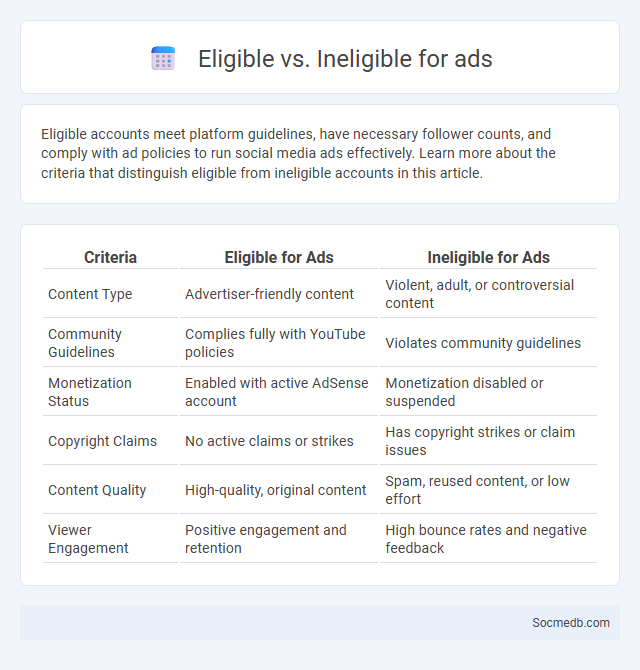
Photo illustration: Eligible vs Ineligible for ads
Eligible accounts meet platform guidelines, have necessary follower counts, and comply with ad policies to run social media ads effectively. Learn more about the criteria that distinguish eligible from ineligible accounts in this article.
Table of Comparison
| Criteria | Eligible for Ads | Ineligible for Ads |
|---|---|---|
| Content Type | Advertiser-friendly content | Violent, adult, or controversial content |
| Community Guidelines | Complies fully with YouTube policies | Violates community guidelines |
| Monetization Status | Enabled with active AdSense account | Monetization disabled or suspended |
| Copyright Claims | No active claims or strikes | Has copyright strikes or claim issues |
| Content Quality | High-quality, original content | Spam, reused content, or low effort |
| Viewer Engagement | Positive engagement and retention | High bounce rates and negative feedback |
Understanding Ad Eligibility on YouTube
Understanding ad eligibility on YouTube requires knowledge of the platform's community guidelines and advertiser-friendly content policies, which aim to ensure ads are shown alongside appropriate videos. Your content must avoid sensitive topics such as violence, adult content, or harmful misinformation to qualify for monetized ads. YouTube's algorithm evaluates video metadata, viewer engagement, and compliance with advertiser criteria to determine if your content is eligible for ads.
Overview of Monetization Symbols: Green vs Yellow Dollar Sign
Social media platforms use distinct monetization symbols such as the green dollar sign and the yellow dollar sign to indicate different revenue statuses for content creators. The green dollar sign typically signifies that your content is fully eligible for monetization, generating ad revenue and sponsorship opportunities without restrictions. In contrast, the yellow dollar sign reflects limited or conditional monetization, often due to content that may not meet all advertiser-friendly guidelines, impacting your potential earnings.
What Makes a Video Eligible for Full Monetization?
A video is eligible for full monetization on social media platforms if it complies with community guidelines, contains original content, and avoids copyrighted material without proper permissions. Engagement metrics such as watch time, viewer retention, and audience interaction also influence monetization eligibility. Ad-friendly content that steers clear of sensitive topics like violence, hate speech, or explicit language maximizes revenue potential.
Common Reasons for Yellow Dollar Sign (Limited Ads)
The yellow dollar sign on social media platforms commonly appears due to content that violates advertising guidelines, including use of copyrighted material or inappropriate language. Posts marked with limited ads often contain sensitive topics such as politics, adult content, or controversial issues that restrict monetization options. Understanding and adhering to platform-specific ad policies ensures better visibility and revenue opportunities for creators and businesses.
Content Types Considered Ineligible for Ads
Social media platforms typically consider content promoting illegal activities, violence, hate speech, or misinformation ineligible for ads. Advertisements containing adult content, misleading claims, or discriminatory messages are strictly prohibited to maintain community standards. Furthermore, content related to sensitive topics such as tobacco, drugs, or gambling faces significant restrictions to protect user safety and comply with regulations.
Navigating YouTube’s Ad-Friendly Content Guidelines
Navigating YouTube's ad-friendly content guidelines requires understanding policies on advertiser suitability, including restrictions on sensitive topics, profanity, and controversial issues. Creators must ensure videos align with community standards and maintain high content quality to maximize ad revenue opportunities. Compliance with YouTube's algorithm-driven review processes enhances visibility and monetization potential on the platform.
How to Appeal Yellow Dollar Sign Monetization Decisions
Understanding YouTube's yellow dollar sign monetization decisions requires closely examining the platform's content guidelines and advertiser-friendly policies. Content that is deemed sensitive, controversial, or not suitable for all advertisers often triggers the yellow dollar sign, limiting ad revenue potential. To appeal these decisions, thoroughly review YouTube's appeal process, provide clear context about your content, and demonstrate compliance with the community standards to increase the chances of restoring full monetization.
Best Practices for Staying Eligible for Ads
Maintaining eligibility for social media ads requires strict adherence to platform guidelines and community standards, including avoiding prohibited content like misinformation, hate speech, or adult material. You should regularly review ad policies, use clear and truthful messaging, and ensure your target audience complies with age and location restrictions. Consistently monitoring ad performance and promptly addressing any violations preserves your account's credibility and long-term advertising success.
Frequently Flagged Topics Resulting in Limited Ads
Frequently flagged topics on social media that result in limited ads include sensitive subjects such as politics, health misinformation, and controversial social issues. Platforms like Facebook and Instagram use strict algorithms to identify content related to hate speech, violence, and adult themes, restricting advertising to comply with their policies and legal regulations. Advertisers targeting demographics exposed to flagged content often experience reduced reach and engagement due to these ad limitations.
Tips to Maximize Ad Revenue and Avoid Ineligible Content
Maximize your social media ad revenue by targeting high-engagement audiences with precise demographics and timely content. Use clear, consistent messaging while adhering strictly to platform policies to avoid ineligible content that can suspend your account. Regularly monitor ad performance metrics and adjust strategies to maintain compliance and optimize earnings effectively.
 socmedb.com
socmedb.com